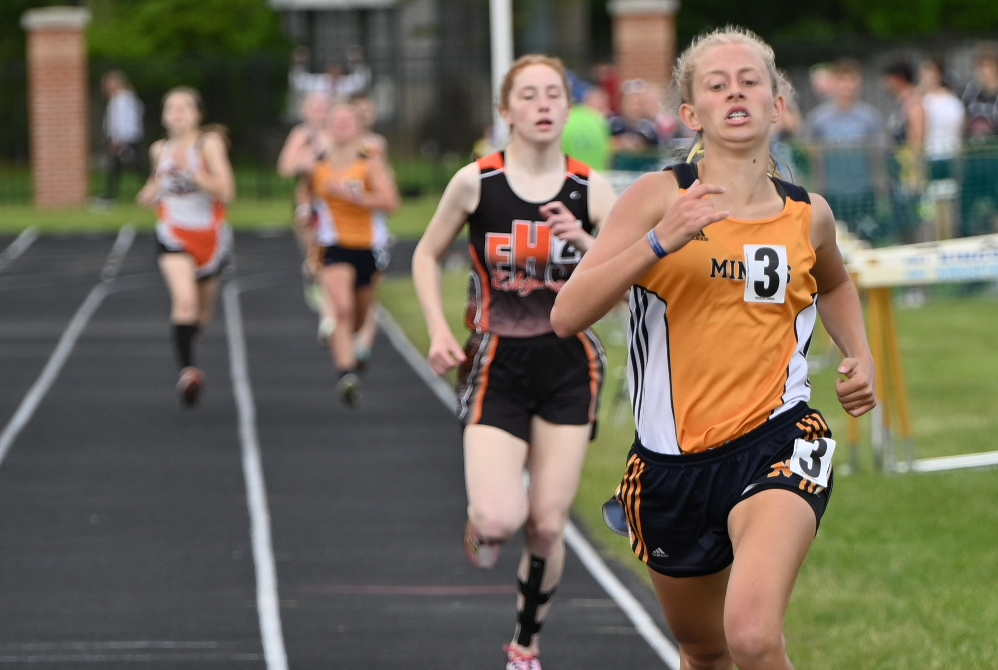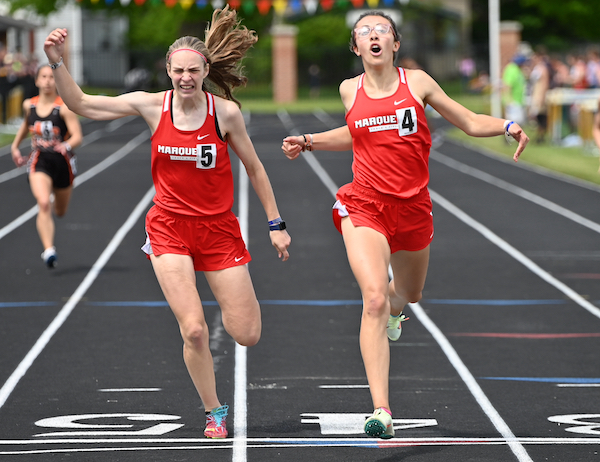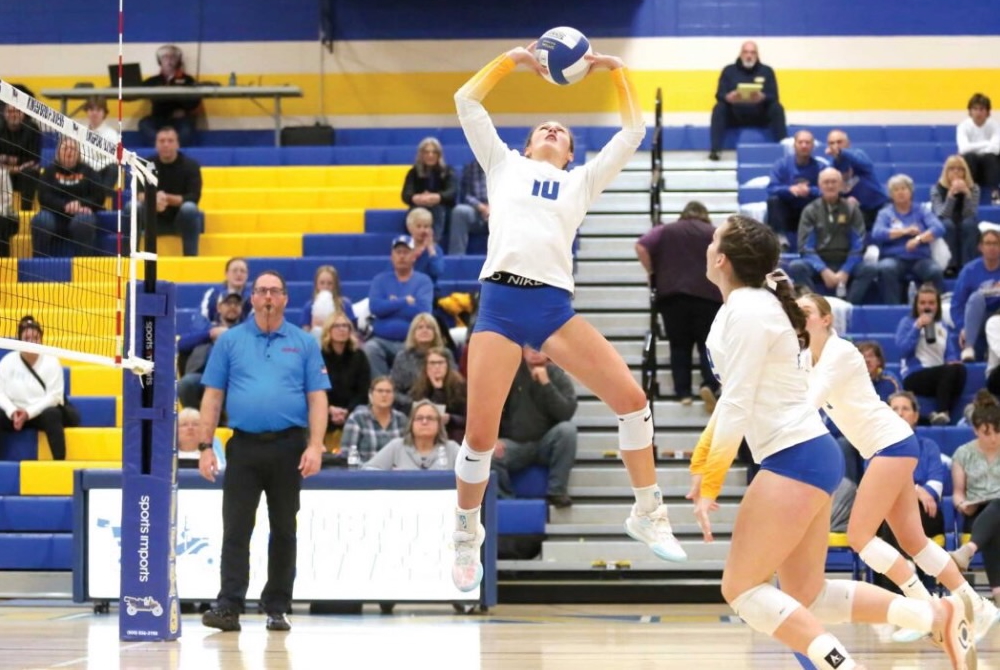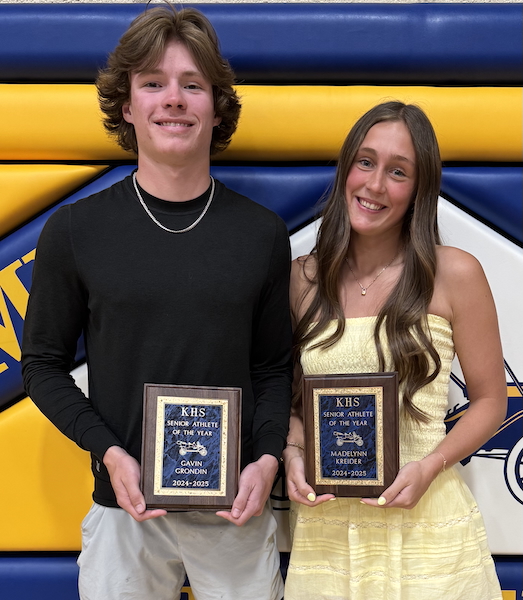
Negaunee Out-Throws, Out-Races Expectations to Reign in UPD1
By
John Vrancic
Special for MHSAA.com
June 5, 2022
KINGSFORD — The Negaunee girls were ranked third coming into the Upper Peninsula Division 1 Track & Field Finals here Saturday.
Apparently, the Miners didn’t pay much attention to that as they captured their first title in four years with 119½ points. They were followed by two-time reigning champion Marquette with 98 and Sault Ste. Marie at 86.
“They outperformed their ranking,” said Negaunee coach Vickie Paupore. “Every single girl stepped up. I’m so proud of their grit and determination. Endla (Harris) was ranked eighth and placed second in the 1,600 (5:43.82) and Madison Pekrul winning the 100 hurdles (17.35) and taking second in the 300s (50.32) is an example of a freshman stepping up. We have good senior leaders, and they got the job done today. I appreciate the effort of all the assistant coaches. They make my job so much easier.”
In the weight events, Negaunee grabbed the top three places in shot put and senior Alyssa Hill, who plans to continue her track & field career at Bemidji (Minn.) State University, won discus at 120 feet.
“I had hoped to throw a little farther in disc,” said Hill, who set the school record at 123-4 in the Regional at Negaunee on May 19. “There was a little bit of wind, and I probably started thinking about it a little too much. I thought I had pretty good technique.
“A lot of girls on our team had PRs (personal records) today. Our 3,200 relay had its best time by about 30 seconds, and Natalie Bell had a PR in shot. We were ranked 1-2-7-8 in shot and got 1-2-3-5. We moved up a little.”
Junior Eliana Juchemich took shot put with a personal-best throw of 36-3¼. Hill was runner-up (32-5½) and Bell took third (31-6½).
 “This is awesome,” she said. “I think my speed was pretty good in the circle, but I had to fix my angle before my release. You want to go with a 45-degree angle. You want to get good enough elevation and yet not too much. If you throw too high, you might not get the distance you want. That was an awesome thing today because everybody wants to win. Our team is real good. We push each other in practice, and it showed today.”
“This is awesome,” she said. “I think my speed was pretty good in the circle, but I had to fix my angle before my release. You want to go with a 45-degree angle. You want to get good enough elevation and yet not too much. If you throw too high, you might not get the distance you want. That was an awesome thing today because everybody wants to win. Our team is real good. We push each other in practice, and it showed today.”
Aubrey Johnson provided Negaunee with an additional first in the 800-meter run (2:30.44).
Marquette showed its speed with Beax Truckey and Julia Ott placing 1-2 in the 100 and 200.
Truckey took the 100 (12.98) and 200 (26.51) and Ott was clocked at 13.01 and 26.59, respectively. The Redettes also captured the 400 (51.99) and 800 relays (1:48.37).
Sault Ste. Marie’s Claire Erickson won the 300 hurdles (49.55) and Cassandra Gallagher took the 3,200 (12:36.83).
Houghton senior and Michigan Tech recruit Ingrid Seagren, who led the entire 3,200 until the final home stretch, was runner-up (12:37).
“This is a real heartbreaker,” said Seagren, who helped the Gremlins win the 3,200 relay (10:19.08). “I’m disappointed in my finish.
“(But) we ran a decent time in our relay. I’m proud of our team.”
Escanaba senior Ciara Ostrenga won the 400 in a personal-best 1:00.22 and helped the winning 1,600 relay (4:16.27).
“After we got fourth in the 3,200 relay, I just wanted to work hard and try to leave here with an individual medal,” she said. “I think our relay did pretty good. All the girls worked and tried hard.”
Houghton's Maria Velat competed in the first-time adaptive events in the 100 (26.56), 200 (51.15), 400 (1:35.96) and shot put (10-0).
PHOTOS (Top) Negaunee’s Aubrey Johnson charges toward the finish on the way to winning the 800 on Saturday. (Middle) Marquette’s Julia Ott (5) and Baux Truckey (4) have a close finish in the 200, with Truckey edging her teammate by eight hundredths of a second. (Click for more from Cara Kamps/Run Michigan.)

Kingsford's Kreider Prepared for Next Level After Finishing Stellar Flivvers Career
By
John Vrancic
Special for MHSAA.com
June 19, 2025
KINGSFORD — After completing a successful high school volleyball career, Maddy Kreider is ready to take the next step.
 The Kingsford senior is taking her talents to Michigan Tech, where she’s expected to continue primarily as a setter.
The Kingsford senior is taking her talents to Michigan Tech, where she’s expected to continue primarily as a setter.
“That will be a big step for sure, but it’ll be exciting being with the girls,” she said. “The girls are taller in college. It will definitely be an adjustment, physically and mentally. We’ll be traveling longer distances, and it’ll be a matter of improving the mental part of my game.”
Kreider was selected the Upper Peninsula’s Defensive Player of the Year her final two seasons after the U.P. Sportswriters and Sportscasters Association began voting for all-U.P. volleyball.
“That’s quite an accomplishment,” she said. “It’s a real honor playing with girls I grew up with. We had a great season.”
The 5-foot-8 setter was a four-year starter and two-year team captain at Kingsford, leading the Flivvers to three Division 2 District titles and back-to-back undefeated Great Northern Conference championships. She twice was named GNC Player of the Year.
She was also selected all-state first team in the fall and all-state second team in 2023, and all-region throughout her prep career. Her serving percentage also topped .900 throughout her four seasons on varsity.
 Last fall, the Flivvers reached the Regional Semifinal at Manistique where they dropped a 3-2 decision to Kingsley.
Last fall, the Flivvers reached the Regional Semifinal at Manistique where they dropped a 3-2 decision to Kingsley.
“I thought we’d get through,” Kreider said. “We came out lights out in the first two sets, then it was close in the last three.”
Also among the team’s highlights this past fall was a victory at Calumet, approximately 2½ weeks after dropping a 3-1 decision to the Copper Kings on Kingsford’s home floor.
“We wanted to play them,” Kreider said. “They’re a great bunch of girls to play against. They’ve been the measuring stick up here for many years. Winning on their floor was super exciting. We knew we had to play well just to be competitive. That was a great confidence builder for our group. We were definitely on a high going into the District.”
The Flivvers opened their postseason with a 3-1 triumph over Houghton, then defeated Escanaba in straight sets in the District Final.
Kreider will join Calumet senior Maddie Torola at MTU this fall. Torola, who recorded a season-high 19 kills in the four-set victory at Kingsford, helped the Copper Kings finish 29-5 and reach the Division 3 Regional Final at Sault Ste. Marie where they dropped a 3-2 decision to Traverse City St. Francis.
“It was fun playing against her in high school,” Kreider said. “It will be even more fun playing as teammates. It’ll be exciting to be playing on the same team.”
Both will be playing under new head coach Cindy Pindral at Tech. Both of Kreider’s parents played for the Huskies, her mother (and Kingsford varsity coach) Jaclynn volleyball from 1998-2002 and her father Jason basketball from 1997-2000.
Maddy Kreider recently earned an additional honor when she was selected Female Athlete of the Year for Kingsford’s Class of 2025. She recently completed a solid track & field season for the Flivvers.
At the U.P. Division 1 Finals, Kreider placed fourth in the 100-meter dash (13.2) and anchored the Flivvers to a third-place finish in the 800 relay (1:51.57) and fourth in the 400 (53.03) on their home track.
Kreider was named one of 32 MHSAA/Farm Bureau Insurance Scholar-Athlete Award winners this winter and plans to study exercise science and kinesiology at MTU.
 John Vrancic has covered high school sports in the Upper Peninsula since joining the Escanaba Daily Press staff in 1985. He is known most prominently across the peninsula for his extensive coverage of cross country and track & field that frequently appears in newspapers from the Wisconsin border to Lake Huron. He received the James Trethewey Award for Distinguished Service in 2015 from the Upper Peninsula Sportswriters and Sportscasters Association.
John Vrancic has covered high school sports in the Upper Peninsula since joining the Escanaba Daily Press staff in 1985. He is known most prominently across the peninsula for his extensive coverage of cross country and track & field that frequently appears in newspapers from the Wisconsin border to Lake Huron. He received the James Trethewey Award for Distinguished Service in 2015 from the Upper Peninsula Sportswriters and Sportscasters Association.
PHOTOS (Top) Kingsford’s Maddy Kreider sets for her teammates during a match last season. (Middle) Kreider, right, takes a photo with Kingsford’s Male Athlete of the Year Gavin Grondin. (Photos provided by the Kingsford athletic department.)

